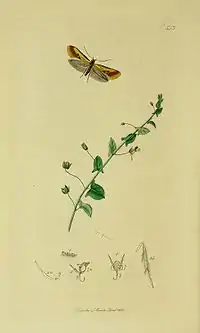Batia lunaris
The Lesser Tawny Crescent (Batia lunaris) is a species of gelechioid moth. It belongs to the subfamily Oecophorinae of the concealer moth family (Oecophoridae). It is the type species of the genus Batia, which is sometimes treated as monotypic. But this is not well warranted, as some other species usually placed there differ little from the Lesser Tawny Crescent.[1]
| Lesser Tawny Crescent | |
|---|---|
 | |
| Adult at Goes (The Netherlands) | |
| Scientific classification | |
| Kingdom: | |
| Phylum: | |
| Class: | |
| Order: | |
| Family: | |
| Genus: | |
| Species: | B. lunaris |
| Binomial name | |
| Batia lunaris (Haworth, 1828) | |
| Synonyms | |
|
Numerous, see text | |
Description and ecology
Its wingspan is 7–10 mm, and in general the imagines (adults) resemble the close relative B. lambdella, but are only two-thirds the size of that species. Their forewings are dark ochre, slightly darker at the tips and the hairy fringe surrounding them. At the border between the light and dark parts there is a dark blotch at the dorsal margin, which forms a continuous pointed patch if the wings are laid back while the moth rests.[2]

It is found in Europe, where it is not rare in many woodlands. It is even widespread at the outer limit of its range, being a common sight in most of England for example. The adults fly in July and August depending on the location. This moth is generally nocturnal, but can be attracted by bright lights. The habits of their caterpillars are not sufficiently known; there is no reason to assume that they differ in that respect from their relatives, which generally live under bark and eat rotting wood and sometimes fungi.[3]
Synonyms
Junior synonyms of B. lunularis are:.[4]
Footnotes
- Pitkin & Jenkins (2004), Kimber [2010], and see references in Savela (2003)
- Kimber [2010]
- Grabe (1942), Kimber [2010]
- Grabe (1942), Pitkin & Jenkins (2004), and see references in Savela (2003)
- Entz, Chuck (August 2006). "Species Batia lunaris - Hodges#1049". Bugguide supported by Iowa State University Department of Entomology.
References
- Grabe, Albert (1942): Eigenartige Geschmacksrichtungen bei Kleinschmetterlingsraupen ["Strange tastes among micromoth caterpillars"]. Zeitschrift des Wiener Entomologen-Vereins 27: 105-109 [in German]. PDF fulltext
- Kimber, Ian [2010]: UKMoths – Batia lunaris. Retrieved 2010-APR-28.
- Pitkin, Brian & Jenkins, Paul (2004): Butterflies and Moths of the World, Generic Names and their Type-species – Batia. Version of 2004-NOV-05. Retrieved 2010-APR-28.
- Savela, Markku (2003): Markku Savela's Lepidoptera and some other life forms – Batia lunaris. Version of 2003-DEC-29. Retrieved 2010-APR-28.
